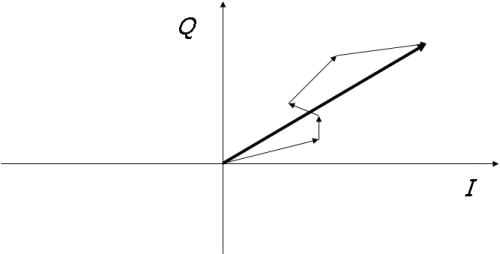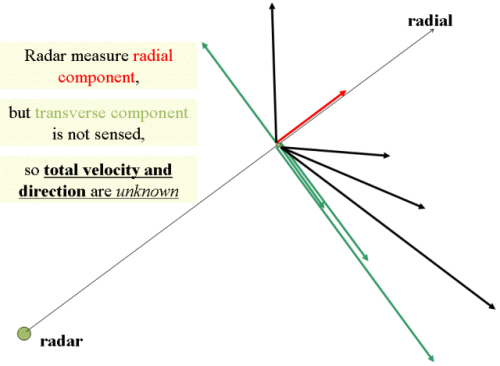Velocity Determination
When a pulse of energy from a radar interacts with a stationary raindrop it forces molecular vibrations which are synchronized with the frequency of the radar pulse. The vibrating molecules in turn emit electromagnetic energy at the same frequency as the incident wave. If however the raindrop has a radial component of velocity towards the radar, its vibrational frequency is higher by Vr/λ because its molecules will experience a more rapid fluctuation of the incident electromagnetic field. The rain drop will then emit electromagnetic radiation at this higher frequency which when backscattered to the stationary radar will have a Doppler shifted frequency.
Fd = -2Vr/λ
where Vr is positive for radial outflow. Similar reasoning will show that there will be no Doppler shift in the forward scattered direction.
Consider a target moving radially away from the radar at speed v.
Consider two successive pulses sent out by the radar:
At time t radar sends Pulse l …

Figure 2. For Pulse 1: Distance travelled by pulse = 2 r
Number of wavelengths along path = 2 r / λ
If the radar’s pulse repetition time is T then …
At time t+T radar sends out Pulse 2 …

Figure 3. For Pulse 2: Distance travelled by pulse = 2 r + 2 vT
Number of wavelengths along path = (2 r + 2 vT) / λ
Note that Pulse 2 has to travel a distance 2vT further than Pulse 1.
Pulse 2 has travelled 2 vT / λ wavelengths further than Pulse 1.
The return from Pulse 2 reaching the radar will be phase-shifted by
2π (2 vT / λ) radians compared to the return from Pulse 1.
By measuring the phase shift over several pulses the mean radial
velocity of the rain drop can be determined. This procedure is termed
pulse pair processing because the phase shift between consecutive pairs
of pulses is used to calculate the radial velocity.
The measured phase shift is used to calculate velocity, i.e.:
phase shift = Δθ = 4πvT / λ
so velocity = v = (λ / 4πT) Δθ
Radar really measures in phase I and quadrature Q components rather than amplitude A and phase shift θ:

I = component in phase with transmitted pulse
Q = component in phase with +90 degree phase shifted version of transmitted pulse
← Figure 4: The phase shift of the radar pulse is the sum of the phase and quadrature of the signal
All of the above applies to a single, moving target and is thus simplified. The target for weather radars is not just one raindrop, but a multitude of raindrops moving with many different velocities. The returns from individual drops interfere constructively and destructively to effect the received signal. This leads to large variations in the amplitude and phase of the backscattered signal received at the radar from pulse to pulse. Nevertheless, if a sufficiently large number of samples are taken (typically 32 pulses) then the received power and mean Doppler shift provides a good estimate of reflectivity and radial velocity in the sample volume.

In the module on Radar Reflectivity it was shown that the backscattered
power is strongly dependent on drop size. The strength and phase of the
received signal is therefore largely determined by the density of
larger drops in the sample volume even though these might be much less
numerous. Fortunately the larger drops will tend to move with the mean
flow within the sample volume and will be much less effected by small
scale turbulent flow in comparison to the very small drops. Measuring
the Doppler velocity of these drops will therefore provide a good
estimate of the mean wind.
Figure 5 (on the right, above): The returned signal is a vector sum of returns from individual particles. A sinusoidal wave with frequency almost exactly = f but with amplitude and phase given by the vector sum of the individual scatterers in the pulse volume.

Note that Doppler radars only measure the radial component of velocity
(because they only measure the change in the target’s range)
The transverse component of velocity is not sensed,
so the total velocity of the target is unknown
Figure 6: Illustration of the measured radial component with the traverse components.